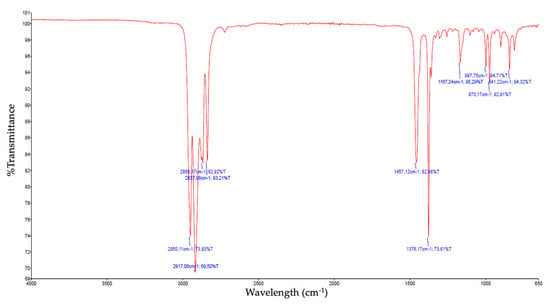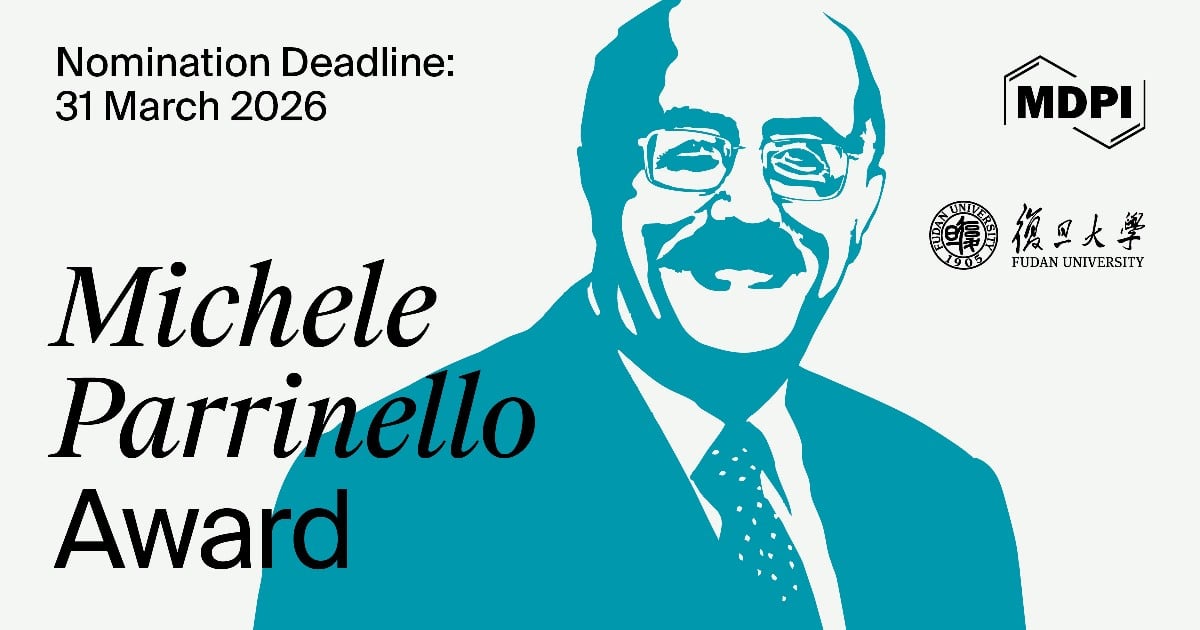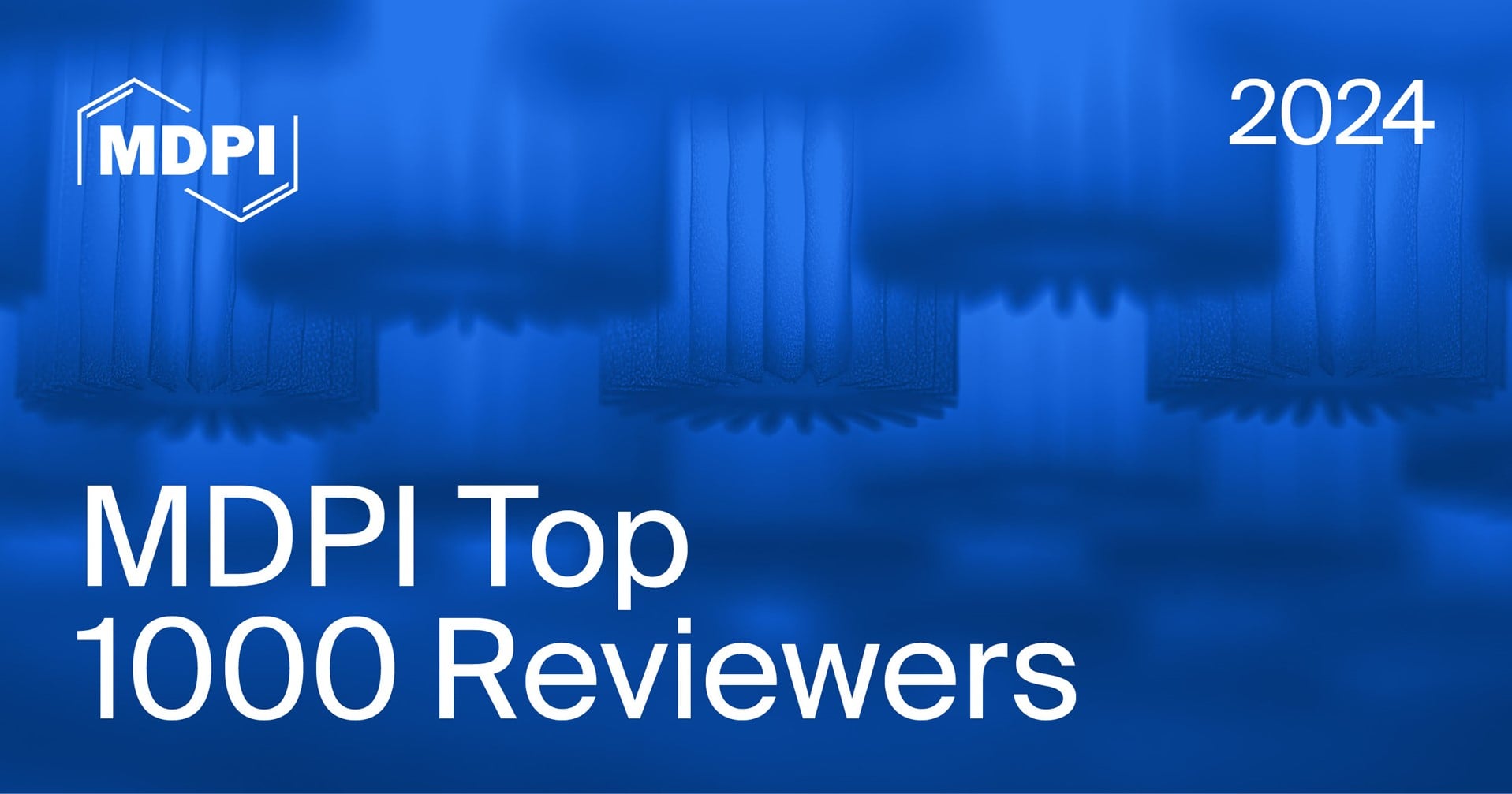-
 The Plastic Signature: Microplastic Ingestion and Phthalate Exposure in Parapenaeus longirostris from Three Tyrrhenian Sites (Mediterranean Sea)
The Plastic Signature: Microplastic Ingestion and Phthalate Exposure in Parapenaeus longirostris from Three Tyrrhenian Sites (Mediterranean Sea) -
 The Fate of Biodegradable Plastic Items Under Conditions of State-of-the-Art Composting
The Fate of Biodegradable Plastic Items Under Conditions of State-of-the-Art Composting -
 Microplastic Accumulation in Urban Stream Sediments: Vertical Distribution and Transport Dynamics
Microplastic Accumulation in Urban Stream Sediments: Vertical Distribution and Transport Dynamics -
 Exploring the Role of Polystyrene Microplastics in Cu Binding in Sea Surface Waters: An Experimental Perspective for Future Research
Exploring the Role of Polystyrene Microplastics in Cu Binding in Sea Surface Waters: An Experimental Perspective for Future Research
Journal Description
Microplastics
Microplastics
is an international, peer-reviewed, open access journal on the science and technology of primary and secondary microplastics published quarterly online by MDPI.
- Open Access— free for readers, with article processing charges (APC) paid by authors or their institutions.
- High Visibility: indexed within ESCI (Web of Science), Scopus, EBSCO, and other databases.
- Journal Rank: JCR - Q1 (Environmental Sciences) / CiteScore - Q1 (Environmental Science (miscellaneous))
- Rapid Publication: manuscripts are peer-reviewed and a first decision is provided to authors approximately 34.6 days after submission; acceptance to publication is undertaken in 5.9 days (median values for papers published in this journal in the first half of 2025).
- Recognition of Reviewers: APC discount vouchers, optional signed peer review and reviewer names are published annually in the journal.
- Journal Cluster of Polymer and Macromolecular Science: Polymers, Gels, Polysaccharides, Textiles, Macromol, Microplastics and Adhesives.
Impact Factor:
5.1 (2024);
5-Year Impact Factor:
5.2 (2024)
Latest Articles
Synthesis of Novel Bismuth-Based Catalysts for the Degradation of Microplastics in Aquatic Matrices
Microplastics 2025, 4(4), 101; https://doi.org/10.3390/microplastics4040101 - 5 Dec 2025
Abstract
►
Show Figures
Microplastics are one of the most widely studied and concerning contaminants, as they are present in all environmental compartments, especially water bodies. Wastewater treatment plants are one of the most important pathways through which these pollutants enter the environment. Currently, novel techniques are
[...] Read more.
Microplastics are one of the most widely studied and concerning contaminants, as they are present in all environmental compartments, especially water bodies. Wastewater treatment plants are one of the most important pathways through which these pollutants enter the environment. Currently, novel techniques are being developed to eliminate microplastics from wastewater, including heterogeneous photocatalysis. In this study, two bismuth-based photocatalysts were synthesized using different methods: BiPO4 by the solvothermal method, and Bi2O3/TiO2 by the wet impregnation method. These were morphologically and structurally characterized. Both photocatalysts were then tested in laboratory-scale experiments to evaluate their effectiveness on the degradation of polypropylene microplastics under UV irradiation in ultrapure water. The effectiveness of the treatment was estimated by measuring the reduction in the area of each of the microplastics, and structural changes were assessed using infrared spectroscopy (FTIR). It was found that the BiPO4 catalyst was more effective when applying UV-B radiation, achieving a reduction in the area of microplastics of up to 10.81%, while the Bi2O3/TiO2 catalyst showed a higher efficiency when applying UV-A, achieving a reduction in the area of microplastics of up to 9.15%. The study of microplastics by ATR-FTIR revealed the appearance and modification of some absorption bands, which indicates incipient degradation. The application of both catalysts in real wastewater showed a reduction in the efficiency of the treatment; hence, further studies should be conducted to determine the influence of other variables in the photocatalytic process. In the current context of growing environmental concern, the development of new, easily synthesized catalysts represents a key strategy for reducing or eliminating MPs. This study presents significant advances in the formulation and evaluation of innovative catalysts, demonstrating their potential as effective and accessible tools for mitigating one of the most pressing global pollution challenges.
Full article
Open AccessSystematic Review
Microplastic Concentration in Mediterranean Commercial Fish: A Systematic Review
by
Stefania M. Manolaki, Panagiotis D. Dimitriou, Maria Lampa, Ioannis Karakassis and Nafsika Papageorgiou
Microplastics 2025, 4(4), 100; https://doi.org/10.3390/microplastics4040100 - 5 Dec 2025
Abstract
Nowadays, microplastic (MP) pollution has attracted increasing interest from the scientific community. This systematic review investigated the MP concentration in various tissues of five commercial fish species (Engraulis encrasicolus, Boops boops, Sardina pilchardus, Sardinella aurita, and Trachurus mediterraneus
[...] Read more.
Nowadays, microplastic (MP) pollution has attracted increasing interest from the scientific community. This systematic review investigated the MP concentration in various tissues of five commercial fish species (Engraulis encrasicolus, Boops boops, Sardina pilchardus, Sardinella aurita, and Trachurus mediterraneus) in different Mediterranean water bodies in order to identify spatial trends and key analytes influencing their variation. The reported concentrations of MPs in all fish ranged from 4.2 particles/individual in the southeastern Mediterranean to 1.2 particles/individual in the western part, but these values are highly uncertain due to inconsistent methodologies, absence of recovery tests, and incomplete data reporting. No significant difference was found in the MP concentration of the different tissues of these species. The key factor affecting the MP concentration was the water body from which they were collected. This systematic review suggests that fewer than six samples may not provide statistically reliable results, and that a lack of detailed data reporting, despite the advances in chemical characterization techniques, continues to limit the robustness of MP studies. Additionally, this study evaluated how methodological differences could influence the reported MP concentrations. These findings offer a comprehensive overview of the MP expansion in the Mediterranean waterbodies and fish species, and provide recommendations for future research design improvement.
Full article
(This article belongs to the Collection Feature Papers in Microplastics)
►▼
Show Figures
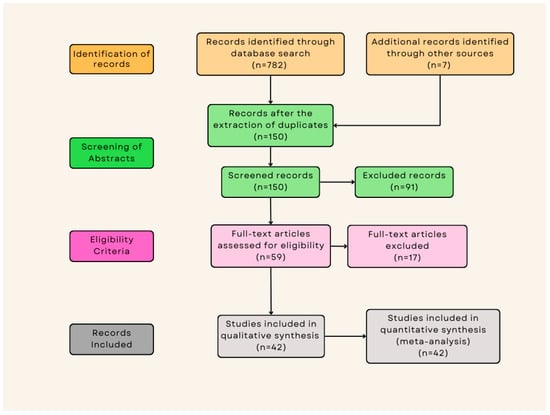
Figure 1
Open AccessSystematic Review
Biochar for the Removal of Microplastics from Water: A Comprehensive Scoping Review
by
Abas Mohsenzadeh, Maria Persson, Anita Pettersson and Flemming Jappe Frandsen
Microplastics 2025, 4(4), 99; https://doi.org/10.3390/microplastics4040099 (registering DOI) - 3 Dec 2025
Abstract
►▼
Show Figures
Microplastics (MPs) and nanoplastics (NPs) are emerging aquatic contaminants that pose environmental and public health risks due to their persistence, ubiquity, and ability to adsorb co-contaminants. This scoping review synthesises findings from 57 experimental studies and five review studies published between 2019 and
[...] Read more.
Microplastics (MPs) and nanoplastics (NPs) are emerging aquatic contaminants that pose environmental and public health risks due to their persistence, ubiquity, and ability to adsorb co-contaminants. This scoping review synthesises findings from 57 experimental studies and five review studies published between 2019 and 2025 on the use of biochar-based materials for the removal of microplastics from water and wastewater. Guided by the hypothesis that surface-modified biochars, such as magnetised, surfactant-coated, or chemically activated forms, achieve high removal efficiencies through multimodal mechanisms (e.g., electrostatic attraction, hydrophobic interactions, π–π stacking, and physical entrapment), this review applies PRISMA-based protocols to systematically evaluate biochar feedstocks, pyrolysis conditions, surface modifications, polymer types, removal mechanisms, and regeneration approaches. Scopus, Web of Science, and PubMed were searched until 30 May 2025 (English-only), and 62 studies were included. The review was not registered, and no protocol was prepared. The results confirm a high removal efficiency (>90%) in most experimental studies, particularly under controlled laboratory conditions and using pristine polystyrene. However, the performance declines significantly in complex matrices (e.g., wastewater and surface water) owing to dissolved organic matter, ionic competition, and particle heterogeneity, thus supporting the guiding hypothesis. This review also identifies critical methodological gaps, including narrow plastic typologies, a lack of standardised testing protocols, and limited field-scale validation. Addressing these gaps through environmentally realistic testing, regeneration optimisation, and harmonised methods is essential for transitioning biochar from a promising sorbent to a practical water treatment solution.
Full article
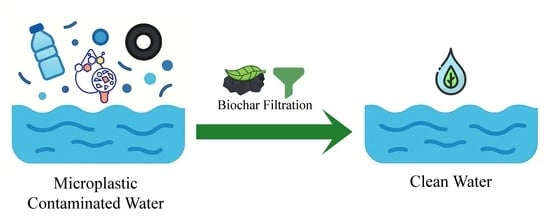
Graphical abstract
Open AccessArticle
Emerging Health Risks Associated with the Intake of Microplastics Found in Milk and Dairy Products
by
Andreea Laura Banica, Cristiana Radulescu, Claudia Lavinia Buruleanu, Radu Lucian Olteanu, Raluca Maria Stirbescu, Sorina Geanina Stanescu and Ioana Daniela Dulama
Microplastics 2025, 4(4), 98; https://doi.org/10.3390/microplastics4040098 (registering DOI) - 3 Dec 2025
Abstract
Microplastic contamination in milk and dairy products is an emerging public health concern due to the potential transfer of polymer particles into the human diet. This study aims to assess the health risks associated with the presence of five major polymers, such as
[...] Read more.
Microplastic contamination in milk and dairy products is an emerging public health concern due to the potential transfer of polymer particles into the human diet. This study aims to assess the health risks associated with the presence of five major polymers, such as poly(methyl methacrylate), polyurethane, polyester, polyethylene, and polyamide, found in a variety of conventional, organic, and raw milk and dairy products. The risk assessment was performed by calculating several indices, including the polymer risk index, concentration factor, daily plastic intake, the chronic daily exposure dose by ingestion, and the plastic risk index. Statistical analyses, including t-test, Pearson correlations, Multilayer Perceptron Analysis, Principal Component Analysis, Scatterplot Matrix, pairwise comparisons, and Multidimensional Scaling, were performed to establish the emerging risks associated with the consumption of contaminated dairy products. The results indicated significant differences in risk parameters between certain product categories, with yogurts, both conventional and organic, showing consistently higher associations with poly(methyl methacrylate), polyurethane, polyester, and polyamide contamination. Strong positive correlations between microplastic concentration and intake-related parameters have confirmed a robust exposure-risk relationship. The exploratory and predictive analyses have revealed product-specific contamination patterns, but no significant association has been observed between product and polymer types. These findings validate the link between microplastic exposure and human health risk and suggest that targeted monitoring of dairy products with high sensitivity is needed to mitigate potential impacts.
Full article
(This article belongs to the Special Issue Microplastics and Human Health: Impact, Challenges and Interaction Mechanisms)
►▼
Show Figures

Graphical abstract
Open AccessReview
Sustainable Magnetic Nanorobots for Microplastics Remediation
by
Sarah Briceño, José Eduardo Arevalo-Fester and Ivan Andres Fierro-Sanchez
Microplastics 2025, 4(4), 97; https://doi.org/10.3390/microplastics4040097 (registering DOI) - 3 Dec 2025
Abstract
►▼
Show Figures
Microplastics have become a major environmental concern due to their resistance to degradation, wide distribution, and potential uptake by organisms. Conventional mitigation strategies often exhibit limitations in efficiency, reuse, and scalability, and may generate secondary pollutants. In this review, we highlight the application
[...] Read more.
Microplastics have become a major environmental concern due to their resistance to degradation, wide distribution, and potential uptake by organisms. Conventional mitigation strategies often exhibit limitations in efficiency, reuse, and scalability, and may generate secondary pollutants. In this review, we highlight the application of magnetically controlled, sustainable nanorobots based on magnetic hybrid nanoparticles with different functional groups to enhance the removal efficiency of microplastics from the environment. By leveraging hydrophobic interactions, surface modifications, and tailored additives, these magnetic nanorobots provide a sustainable, eco-friendly approach to mitigating microplastic pollution and offer improved magnetic separation performance. Bioinspired and biohybrid magnetic nanorobots, based on green synthesis principles, carbon-based nanomaterials, biochar, nature-inspired swarm motion, and collective behavior, present further advancements that mimic biological systems to capture microplastics with high efficiency and recovery. Achieving removal efficiencies often exceeding 90% in minutes, and maintaining the efficiency after several cycles. The synergistic integration of magnetic separability with tailor-made surface functionalities underpins the effectiveness of these magnetic nanorobots, setting the stage for their future commercialization and widespread adoption in water remediation technologies.
Full article

Graphical abstract
Open AccessArticle
Microplastic-Mediated Delivery of Di-butyl Phthalate Alters C. elegans Lifespan and Reproductive Fidelity
by
Chiara Angelyn O. Maldonado, David M. Mares, Paola C. Garcia, Maria F. Gamez, Midori R. Flores, Alyssa D. Friudenberg, Ryan L. Peterson and Jennifer C. Harr
Microplastics 2025, 4(4), 96; https://doi.org/10.3390/microplastics4040096 (registering DOI) - 1 Dec 2025
Abstract
►▼
Show Figures
Microplastics harbor chemical additives and absorb pollutants from the environment. Microplastics pose a human health threat and have been found in nearly all human tissues. The toxicological pathways and physiological effects of microplastic-mediated chemical exposure following ingestion remain unknown. Here we use Caenorhabditis
[...] Read more.
Microplastics harbor chemical additives and absorb pollutants from the environment. Microplastics pose a human health threat and have been found in nearly all human tissues. The toxicological pathways and physiological effects of microplastic-mediated chemical exposure following ingestion remain unknown. Here we use Caenorhabditis elegans to investigate the effects of di-butyl phthalate and polystyrene microplastic mixtures on fertility and lifespan. Our studies demonstrate that 1 µm microplastics at 1 mg/L exposure levels result in decreased brood size, whereas 1000 times fewer microplastics (1 µg/L) did not affect the number of eggs laid. While there was no change in brood size at 1 µg/L microplastic exposure levels, there was an increase in embryonic lethality. Microplastics-mediated delivery of di-butyl phthalate to C. elegans significantly reduced brood size and increased embryonic lethality compared to exposure to microplastics alone. This reproductive toxicity is potentially due to a stress response via DAF-16, as observed with microplastics and di-butyl phthalate co-exposure. Furthermore, chronic exposure (from hatching onward) to microplastics shortened the lifespan of C. elegans, which was further reduced with di-butyl phthalate co-exposure. The exacerbated defects observed with co-exposure to phthalate-containing microplastics underscore the risks associated with microplastics releasing the additives and/or chemicals that they have absorbed from the environment.
Full article

Figure 1
Open AccessCommunication
Promoting Biofilm Formation by Serratia marcescens on Three Types of Artificially Aged Microplastics Under Marine Conditions
by
Manildo Marcião de Oliveira, Nikolas Gomes Silveira de Souza, Rachel Ann Hauser-Davis, Renato Matos Lopes, Victor Barbosa Saraiva, Ocimar Ferreira de Andrade, Jader Lugon, Jr., Antônio Silva Neto, Carla C. C. R. de Carvalho and Ramiro Neves
Microplastics 2025, 4(4), 95; https://doi.org/10.3390/microplastics4040095 (registering DOI) - 1 Dec 2025
Abstract
►▼
Show Figures
Bacterial biofilms on different types of microplastics in aquatic environments have become an increasing ecological and public health concern. In this context, this study investigated biofilm formation on virgin and aged microplastics under marine conditions. Serratia marcescens biofilm formation was observed on both
[...] Read more.
Bacterial biofilms on different types of microplastics in aquatic environments have become an increasing ecological and public health concern. In this context, this study investigated biofilm formation on virgin and aged microplastics under marine conditions. Serratia marcescens biofilm formation was observed on both virgin and aged polyethylene particles after 7 days, with no significant changes by day 14. Concerning polypropylene microplastics, biofilms developed on aged particles but were not detectable on virgin particles, likely due to interference from the polypropylene red color matching S. marcescens cells. In contrast, expanded polystyrene spheres showed an initial biofilm formation that dissipated by day 14, potentially due to toxic residues from photooxidation, including potential styrene monomers and other chemical additives, inhibiting biofilm persistence. These findings indicate differences in biofilm formation across microplastics types, which may influence microplastic buoyancy and ecological impacts. Thus, microplastic color and additives should be considered in future studies on microplastics biofilm formation and biofouling.
Full article

Figure A1
Open AccessArticle
The Effect of Subchronic Polyethylene Microplastic Exposure on Pulmonary Fibrosis Through Pro-Inflammatory Cytokines TNF-α and IL-1β in Wistar Rats
by
Prehatin Trirahayu Ningrum, Soedjajadi Keman, I Ketut Sudiana, Lilis Sulistyorini, Saliza Mohd Elias, Tri Marthy Mulyasari and Abdullah Al Mamun
Microplastics 2025, 4(4), 94; https://doi.org/10.3390/microplastics4040094 - 27 Nov 2025
Abstract
►▼
Show Figures
The lungs function as the organs responsible for the respiratory system and they are essential for breathing, where any dysfunction can impair the respiratory processes. Pulmonary fibrosis is a lung disease that progresses slowly and is not contagious. The purpose of this study
[...] Read more.
The lungs function as the organs responsible for the respiratory system and they are essential for breathing, where any dysfunction can impair the respiratory processes. Pulmonary fibrosis is a lung disease that progresses slowly and is not contagious. The purpose of this study was to analyze the effect of airborne microplastic exposure on the expression of TNF-α and IL-1β cytokines, and on fibroblast cell formation in Rattus norvegicus Wistar strain rats. This research was a quantitative analytical study with a laboratory experimental approach that used experimental animals as research subjects. The research design was a true experimental design with a randomized posttest-only group design. The research was conducted at the molecular level, and the indicators measured were molecular biomarkers. This design involved dividing the experimental animals into six groups: a control group (X0) and five treatment groups (X1, X2, X3, X4, and X5), which received doses of 0.025, 0.5, 1, 2, and 4 mg/L, respectively. Biomarkers and microscopic changes were then measured after 90 days of treatment. In Wistar rats, microplastic exposure significantly increased the expression of TNF-α and IL-1β cytokines, which play an important role in the early phase of the inflammatory response in the lungs, as well as the formation of fibroblast cells as indicators of pulmonary fibrosis. Subchronic inhalation exposure to polyethylene microplastics significantly increased the expression of TNF-α and IL-1β cytokines, and the formation of fibroblast cells, leading to pulmonary fibrosis.
Full article
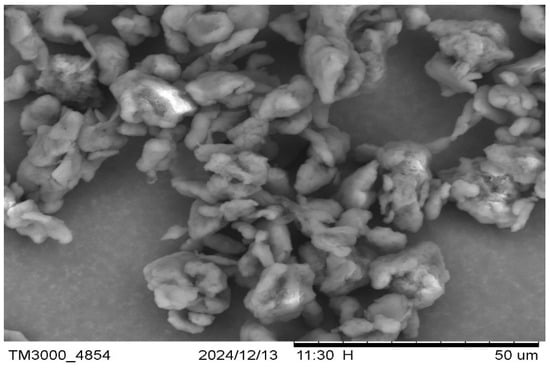
Figure 1
Open AccessReview
Definition of Emerging Microplastic Syndrome Based on Clinical and Epidemiological Evidence: A Narrative Review
by
Umberto Cornelli, Claudio Casella, Giovanni Belcaro, Maria Rosaria Cesarone, Simonetta Marucci, Mariangela Rondanelli, Martino Recchia and Giuseppe Zanoni
Microplastics 2025, 4(4), 93; https://doi.org/10.3390/microplastics4040093 - 26 Nov 2025
Abstract
Microplastics and nanoplastics (MNPs) are pervasive contaminants infiltrating water, food, and human tissues. The sharp rise in plastic production—with over half manufactured between 2003 and 2022—has heightened concerns about their health impacts. Methods included: (1) a literature review of clinical studies on MNPs
[...] Read more.
Microplastics and nanoplastics (MNPs) are pervasive contaminants infiltrating water, food, and human tissues. The sharp rise in plastic production—with over half manufactured between 2003 and 2022—has heightened concerns about their health impacts. Methods included: (1) a literature review of clinical studies on MNPs focusing on human health and (2) analysis of Standardized Mortality Rates (SMRs) for 44 groups of diseases in Italy (2003–2022, Italian National Institute of Statistics, ISTAT data). The outcomes suggest that MNPs have been connected to pathological alterations in a number of organ systems, such as the gastrointestinal tract (intestine, liver, and pancreas), breathing system, eyes, brain, and vascular structures. SMRs increased significantly in only eight of the 46 illness categories examined between 2003 and 2022. The analysis of clinical and epidemiological data allows us to identify a possible clinical assessment consisting of a 30-variable diagnostic questionnaire (Chicago Cluster Evaluation System, CCES), encompassing laboratory markers, clinical signs, and ultrasound findings. A binomial distribution model suggests that more than 8 positive responses may indicate a presumptive diagnosis of Microplastic Syndrome (MP-Sy). This framework reflects observed clinical/epidemiological patterns and provides a foundation for hypothesis-driven research. Prospective longitudinal studies are warranted to validate the proposed definition and its diagnostic utility. The aim of the present study is to propose a preliminary clinical framework for a potential MP-Sy integrating toxicological evidence with epidemiological data, define diagnostic criteria and assess their consistency with observed disease trends.
Full article
(This article belongs to the Special Issue Microplastics and Human Health: Impact, Challenges and Interaction Mechanisms)
►▼
Show Figures

Graphical abstract
Open AccessArticle
Release of Microplastics from Shoe Outsoles into the Environment by Walking and Jogging, and Ingestion of Shoe Outsole Microplastics by Goldfish
by
Sayaka Manabe, Yasuo Shimizu, Tomoyasu Yoshitomi, Ryosuke Fujinuma and Makito Kobayashi
Microplastics 2025, 4(4), 92; https://doi.org/10.3390/microplastics4040092 - 25 Nov 2025
Abstract
►▼
Show Figures
The migration of terrestrial microplastics (MPs) into aquatic environments is considered to have negatively affected aquatic ecosystems. However, quantifying terrestrial pathways is challenging because of the diverse sources of MPs. A poorly understood MP source is shoe outsoles. Therefore, this study determined whether
[...] Read more.
The migration of terrestrial microplastics (MPs) into aquatic environments is considered to have negatively affected aquatic ecosystems. However, quantifying terrestrial pathways is challenging because of the diverse sources of MPs. A poorly understood MP source is shoe outsoles. Therefore, this study determined whether shoes released MPs by abrasion and conducted a series of five experiments to study the potential impacts on aquatic life. The first and second experiments examined the relationship between the distance walked or jogged and the weight loss of shoes. The weight of the shoes decreased significantly as the moving distance increased; however, the values did not differ significantly between walking and jogging. The third experiment tested the size and number of MPs originating from shoe outsole under simulated conditions using sandpaper, which imitated the surface of an asphaltic pavement. The number of MPs increased as the number of contacts with the sandpaper increased. The fourth and fifth experiments examined whether goldfish, Carassius auratus, ingested rubber tips (RTs) derived from the shoe outsoles. When goldfish were given sinking RT or floating RT, they ingested both types of RT with or without feed, suggesting that goldfish recognized RTs as feed. The results of this study suggested that shoes released abrasion debris and particles into the environment as MPs. This study is the first to demonstrate the process of MP release from shoe outsoles and the ingestion of MPs from shoe outsoles by fish.
Full article
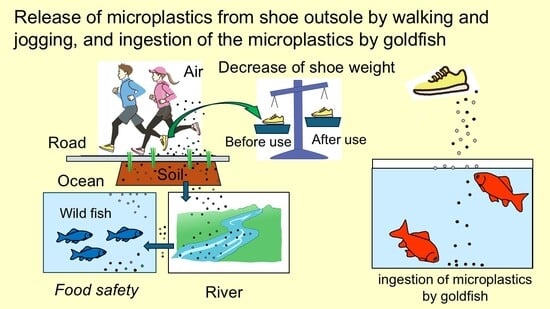
Graphical abstract
Open AccessArticle
Characterization of Microplastics and 6-PPD Quinone in a Suburban Lake–Tributary System Impacted by Highway Runoff
by
Paris M. Velasquez, Lee Green, John Scott and Alan D. Steinman
Microplastics 2025, 4(4), 91; https://doi.org/10.3390/microplastics4040091 - 18 Nov 2025
Abstract
►▼
Show Figures
Characterizing and enumerating microplastics (MPs) have received considerable attention in recent years. Most attention has focused on major waterways and especially in the water column. However, less is known about MPs in smaller lakes and tributaries, as well as in sediments, under both
[...] Read more.
Characterizing and enumerating microplastics (MPs) have received considerable attention in recent years. Most attention has focused on major waterways and especially in the water column. However, less is known about MPs in smaller lakes and tributaries, as well as in sediments, under both baseflow and storm flow conditions. This study examines the role of an unnamed tributary in transporting microplastics and 6PPD-quinone from a major state highway into a small, salt-impacted lake in Grand Rapids, Michigan. Water and sediment samples were collected over a one-year period to characterize microplastic types, abundances, and seasonal variability, while environmental conditions were monitored to assess storm event impacts. Results confirmed widespread microplastic presence in both habitats, with abundances ranging from 61 to 16,390 MPs/L. Many microplastics were black fragments, often unidentifiable but suspected to be rubber-derived. Storm events significantly increased microplastic transport, particularly in the tributary, where concentrations peaked at 16,390/L during fall stormflow. Concentrations of 6-PPD-quinone were very low overall (<1 ng/L), with spikes during storm events in the tributary (up to 201 ng/L). Sediment analysis revealed higher microplastic abundances in the tributary compared to the lake, with black fragments dominating in both habitats. These findings underscore the critical role of storm-driven runoff in microplastic and chemical transport, highlighting the need for improved road infrastructure design to mitigate environmental impacts on downstream water bodies.
Full article
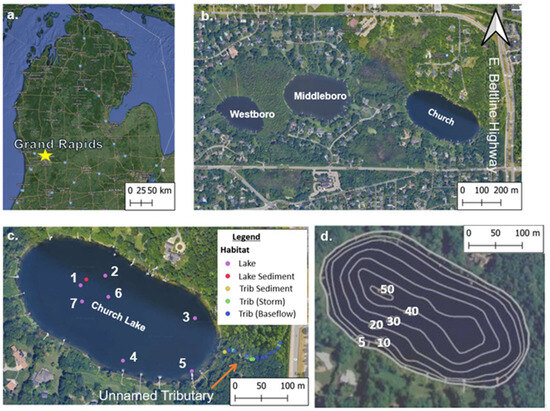
Figure 1
Open AccessArticle
Microplastic Migration from Plastic Packaging into Honey
by
Klytaimnistra Katsara, Zacharias Viskadourakis, Eleftherios Alissandrakis, George Kenanakis and Vassilis M. Papadakis
Microplastics 2025, 4(4), 90; https://doi.org/10.3390/microplastics4040090 - 17 Nov 2025
Abstract
►▼
Show Figures
Prized since antiquity in Greek cultural heritage as a fountain of health and healing and nature’s golden nectar, honey remains one of the world’s most valued natural products. Celebrated for its nutritional, therapeutic, and antimicrobial virtues, honey is now faced with the emerging
[...] Read more.
Prized since antiquity in Greek cultural heritage as a fountain of health and healing and nature’s golden nectar, honey remains one of the world’s most valued natural products. Celebrated for its nutritional, therapeutic, and antimicrobial virtues, honey is now faced with the emerging threat of microplastic contamination. Here, we present direct evidence of microplastic migration into honey, examining real honey samples packaged in flexible plastic pouches, which are commonly offered in cafes all around the world. Such honey samples were tested under different environmental storage conditions (common dry and dark outdoors) and prolonged refrigeration conditions at low temperature, which replicate consumer use. We have identified microplastics using filters and spectroscopic methods in honey from commercial honey pouches, which prove plastic packaging as a contamination source. Additionally, plasticizers were detected in honey that migrated from plastic packaging. The mere fact that microplastics were found in every single storage condition tested and at every time point examined (from day zero of this experiment), while increasing through time, is of great concern for the long-term safety of honey packaging. Our findings emphasize the urgency of reevaluating packaging for honey and other foods, and they open up new perspectives in the study of microplastic migration under real-world conditions.
Full article

Figure 1
Open AccessArticle
Investigating the Potential of Coagulants to Improve Microplastics Removal in Wastewater and Tap Water
by
Claudio Casella, Daniel Sol, Adriana Laca and Mario Díaz
Microplastics 2025, 4(4), 89; https://doi.org/10.3390/microplastics4040089 - 12 Nov 2025
Abstract
►▼
Show Figures
This study investigates the impact of using coagulants on the removal of microplastics (MPs) from wastewater and tap water. Before the settling step, coagulants commonly used in water treatment (FeCl3 or Al2(SO4)3) were added at different
[...] Read more.
This study investigates the impact of using coagulants on the removal of microplastics (MPs) from wastewater and tap water. Before the settling step, coagulants commonly used in water treatment (FeCl3 or Al2(SO4)3) were added at different concentrations to samples taken from an activated sludge reactor and tap water. MPs initially contained in the water samples were chemically and physically characterized, resulting in most of them being fibres smaller than 500 μm, in both media. The use of coagulants improved MPs removal, and the best results were obtained with the aluminum salt, which allowed removal efficiencies of 43% and 62% for tap water and wastewater, respectively. These results demonstrated the potential of coagulants to improve the removal of MPs in treated waters and wastewaters. However, the necessary concentration of the assayed coagulants was quite high, highlighting the interest in investigating their combination with coagulant aids, such as organic polyelectrolytes, which might allow for reduced doses.
Full article
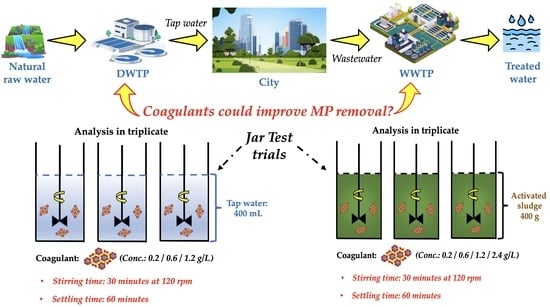
Graphical abstract
Open AccessArticle
Detection, Quantification, and Characterisation of Microplastics in Maltese Bottled Water
by
Josmar Camilleri, Anthea Agius Anastasi and Sophie Marie Briffa
Microplastics 2025, 4(4), 88; https://doi.org/10.3390/microplastics4040088 - 11 Nov 2025
Abstract
►▼
Show Figures
Plastics play a pivotal role in various industries owing to their versatility in engineering their physical, mechanical, and chemical properties while exploiting their remarkable durability, light-weight nature, and cost-effectiveness. Yet, their widespread use has led to the pollution of Earth’s water systems. Over
[...] Read more.
Plastics play a pivotal role in various industries owing to their versatility in engineering their physical, mechanical, and chemical properties while exploiting their remarkable durability, light-weight nature, and cost-effectiveness. Yet, their widespread use has led to the pollution of Earth’s water systems. Over time, plastic waste degrades into microplastics, particles smaller than 5 mm. Recent studies have highlighted the growing concerns associated with microplastics, especially in bottled beverages, including bottled water, with associated hazards still in the very early stages of being fully understood. Furthermore, the global understanding of the extent of microplastic contamination in the environment and along the food chain remains limited. This study aimed to detect, quantify, and characterise microplastics in bottled drinking water produced and sold in Malta. Samples from five brands were filtered, stained with Nile red, and quantified using fluorescence microscopy. The average microplastic concentration was found to be 35,877 ± 23,542 particles per litre, with 84% of samples exhibiting contamination, which was noted to be statistically significant. The average particle diameter was measured to be 2.3696 ± 0.0035 µm. Raman spectroscopy was used to chemically characterise 10 larger particles per brand (i.e., 50 samples), identifying the presence of cellulose, polyurethane, polymethyl methacrylate, polyethylene, and smaller quantities of other polymers. Morphological analysis classified 36 of the larger particles as fragments and 14 as fibres. Excluding laboratory-introduced contamination, the primary source of microplastic contamination in the analysed bottled water was traced to the bottle caps.
Full article
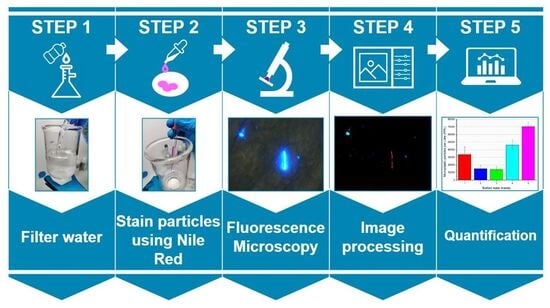
Graphical abstract
Open AccessReview
Microplastics in the Northern Gulf of Mexico: A Literature Review
by
Evelyn McQueen and Eric L. Sparks
Microplastics 2025, 4(4), 87; https://doi.org/10.3390/microplastics4040087 - 10 Nov 2025
Abstract
Plastics have become a ubiquitous feature of modern life, with their presence continually increasing. This widespread use has led to the global proliferation of plastics, including contamination of aquatic environments. This review focuses on microplastics—plastic particles less than 5 mm in size—in the
[...] Read more.
Plastics have become a ubiquitous feature of modern life, with their presence continually increasing. This widespread use has led to the global proliferation of plastics, including contamination of aquatic environments. This review focuses on microplastics—plastic particles less than 5 mm in size—in the Northern Gulf of Mexico. The central objective was to evaluate the abundance and potential impacts of microplastics in the region. Findings appear to indicate that microplastic concentrations in the water are below global averages, while concentrations in shoreline sediments are slightly above average. Although it appears fewer biological specimens contain microplastics in this region, the number of plastic particles per specimen appears higher compared to global observations. Microplastics significantly delay the transition of dissolved organic matter to particulate organic matter (by more than 200%), bioaccumulate in organisms, serve as adsorption surfaces for toxins and pollutants, and cause a range of biological effects. Further research is necessary to accurately quantify microplastic pollution and evaluate its ecological and environmental impacts.
Full article
(This article belongs to the Collection Feature Papers in Microplastics)
►▼
Show Figures

Figure 1
Open AccessArticle
Influence of Urbanization and Seasonality on Microplastics in a Small Brazilian Inland Stream
by
Paulo Guilherme Vardiero Freitas, Andreza Caroline de Paula Oliveira, Lucca Ferreira Mayrink, Eder Carlos Lopes Coimbra, Luciano de Moura Guimarães and Ann Honor Mounteer
Microplastics 2025, 4(4), 86; https://doi.org/10.3390/microplastics4040086 - 7 Nov 2025
Abstract
►▼
Show Figures
Microplastics (MP) are particles under 5 mm that are widespread in the environment and can harm aquatic life by accumulating pollutants. Understanding their distribution and the effects of urbanization and seasonality is key to assessing their impact and developing mitigation strategies. This study
[...] Read more.
Microplastics (MP) are particles under 5 mm that are widespread in the environment and can harm aquatic life by accumulating pollutants. Understanding their distribution and the effects of urbanization and seasonality is key to assessing their impact and developing mitigation strategies. This study investigated the influence of these factors on MP profiles and associated risks in the São Bartolomeu Stream in Viçosa (Minas Gerais, Brazil). Water samples were collected upstream and downstream of the urban center during dry and rainy seasons. Urbanization and seasonality were found to significantly impact MP presence. The abundance of suspected MP particles increased downstream of the urban center during the dry season, from 1.7 to 2.6 MP particles per liter (MP L−1), whereas no significant difference was observed during the rainy season. Subsequent MP identification using Raman spectroscopy confirmed polymer concentrations ranging from 0.05 to 0.32 MP L−1, with a predominance of polypropylene (PP) and polyethylene (PE). However, a critical paradox emerged: standard ecotoxicity tests with the most abundant polymers (PE and PP) revealed no acute or chronic effects on Daphnia similis. However, a risk assessment driven by the chemical identity of less abundant but highly hazardous polymers found in the stream (including polyvinyl chloride, polyacrylonitrile, and polyurethane), classified the aquatic environment with a ‘high’ to ‘extremely high’ ecological risk, highlighting a potential threat from the mixed polymer composition. Thus, the present study reinforces the need for continuous monitoring and mitigation measures to reduce MP contamination in urban aquatic environments.
Full article
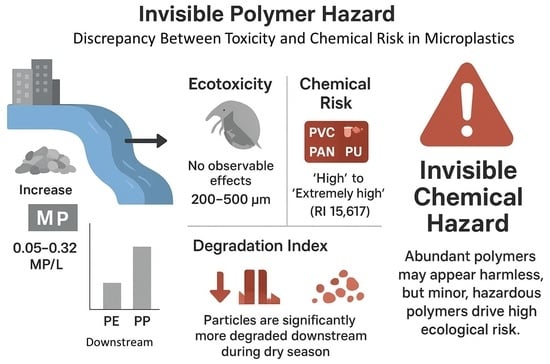
Graphical abstract
Open AccessReview
Microplastics in Lichen Thalli: A Photo or a Movie of Local Atmospheric Deposition?
by
Roberto Bargagli and Emilia Rota
Microplastics 2025, 4(4), 85; https://doi.org/10.3390/microplastics4040085 - 5 Nov 2025
Abstract
►▼
Show Figures
Airborne microplastics (MPs) are a global issue, and there is an urgent need to prevent their spread in the environment. Sensitive and reliable methods are also needed to assess their deposition and effectively evaluate risk in terrestrial ecosystems. Current automated monitoring devices are
[...] Read more.
Airborne microplastics (MPs) are a global issue, and there is an urgent need to prevent their spread in the environment. Sensitive and reliable methods are also needed to assess their deposition and effectively evaluate risk in terrestrial ecosystems. Current automated monitoring devices are expensive and do not enable large-scale mapping of MP deposition. As with other persistent atmospheric contaminants, developing accurate, cost-effective and easily applicable biomonitoring methods would therefore be highly beneficial. Cryptogams are among the most suitable biomonitors of airborne contaminants, and preliminary surveys show that epiphytic lichens accumulate higher concentrations of MPs in urban areas and near landfills than in control sites. However, the interaction between lichen thalli and MPs is weak and, as discussed in this review, the anthropogenic fibres and plastic fragments intercepted and retained by lichens probably do not reflect the levels in bulk atmospheric deposition. While emphasizing the need for studies evaluating the effectiveness of cryptogams in accumulating different types of airborne MPs under various meteorological conditions, this review also suggests directing future research efforts toward mosses, which seem to accumulate much higher concentrations of MPs than lichens in both active and passive biomonitoring surveys.
Full article

Figure 1
Open AccessArticle
Making Fluorescent Nylon, Polypropylene, and Polystyrene Microplastics for In Vivo and In Vitro Imaging
by
Charles E. Bardawil, Jarrett Dobbins, Shannon Lankford, Saif Chowdrey, Jack Shumway, Gayathriy Balamayooran, Cedric Schaack and Rajeev Dhupar
Microplastics 2025, 4(4), 84; https://doi.org/10.3390/microplastics4040084 - 4 Nov 2025
Abstract
►▼
Show Figures
Microplastics (MPs) are synthetic environmental pollutants increasingly linked to adverse human health effects. To study their biological impact, researchers require access to environmentally relevant MPs that can be accurately tracked in biological systems. However, most ambient MPs are composed of non-conjugated polymers that
[...] Read more.
Microplastics (MPs) are synthetic environmental pollutants increasingly linked to adverse human health effects. To study their biological impact, researchers require access to environmentally relevant MPs that can be accurately tracked in biological systems. However, most ambient MPs are composed of non-conjugated polymers that lack intrinsic fluorescence, limiting their utility in live-cell or in vivo imaging. Addressing this challenge, we present two alternative labeling approaches that enable visualization, tracking, and quantification of MPs. First, we stained nylon and polypropylene MPs with Rhodamine 6G, a fluorescent dye known for its stability and compatibility with in vivo applications. These labeled MPs retained strong fluorescence in murine lung tissue for up to one week, as confirmed by fluorescent microscopy. Second, we conjugated aminated polystyrene microspheres with IRDye-800CW, a near-infrared fluorophore that enables high-resolution imaging with minimal tissue autofluorescence via an In Vivo Imaging System and confocal microscopy. In vivo experiments revealed organ-specific accumulation of IRDye-labeled MPs, with a 2.8-fold increase in the liver and a 5-fold increase in spleen compared to controls, detectable up to 72 h post-injection. These labeling strategies provide researchers with practical tools to visualize and study the biodistribution of MPs in biological systems, advancing efforts to understand their health implications.
Full article

Graphical abstract
Open AccessArticle
Differential Effects of the Human Digestive Process on Petroleum- and Bio-Based Microplastics Following an In Vitro Approach to Determine Polymer Integrity and Seafood Digestibility
by
Daniel Bolotas, Rita V. C. Gomes, Ana C. Ambrosino, Clara Lopes, Joana Raimundo, Mónica V. Loureiro, Alda S. Pereira, Pedro Santana, António Marques, Tiago Repolho and Ana Luísa Maulvault
Microplastics 2025, 4(4), 83; https://doi.org/10.3390/microplastics4040083 - 3 Nov 2025
Abstract
►▼
Show Figures
Plastic pollution is a major environmental concern. In humans, ingestion through contaminated seafood is a recognized exposure route to microplastics, which may impact gut health. However, the extent to which microplastics interfere with digestion and nutrient absorption remains unclear. To this end, the
[...] Read more.
Plastic pollution is a major environmental concern. In humans, ingestion through contaminated seafood is a recognized exposure route to microplastics, which may impact gut health. However, the extent to which microplastics interfere with digestion and nutrient absorption remains unclear. To this end, the present work aimed to assess, for the first time, the influence of microplastic particles (polyethylene terephthalate, PET, and polylactic acid, PLA) on the digestibility of three selected seafood species (gilthead seabream, Sparus aurata; Atlantic salmon, Salmo salar; and hard clam, Mercenaria mercenaria) using an in vitro human digestion model. Furthermore, this study evaluated the potential degradability of microplastics along the gastrointestinal tract and examined how particle type and exposure level (10 or 20 particles) may influence seafood digestibility. Protein digestibility in S. aurata and S. salar filets was ~86%, while in M. mercenaria it was ~73%, regardless of microplastic presence or quantity. PET and PLA integrity was affected differently by digestion, with PLA showing greater surface degradation. These findings provide preliminary insight into the mutual interactions between microplastics and the human digestive process, highlighting the importance for further research into how the leaching of plastics additives may or may not influence the bioaccessibility of essential nutrients.
Full article
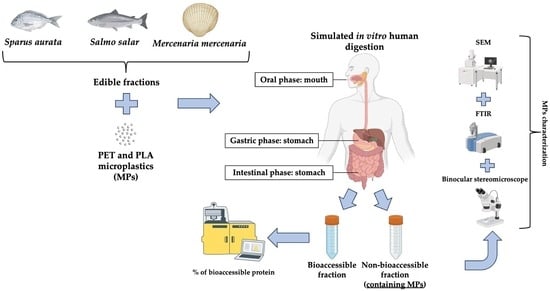
Graphical abstract
Open AccessArticle
Characterization of Plastics Ingested by the Bioindicator Cory’s Shearwater from Tenerife Island (Canary Islands): Implications for Marine Environmental Monitoring
by
Natalia Baena, Gema Paniagua González, Juan Carlos Bravo, Rosa María Garcinuño, Beneharo Rodríguez, Begoña Jiménez, Pilar Fernández-Hernando and Juan Muñoz-Arnanz
Microplastics 2025, 4(4), 82; https://doi.org/10.3390/microplastics4040082 - 3 Nov 2025
Abstract
Plastic pollution is a pressing environmental concern globally, especially in marine ecosystems. In this study, the evaluation of the potential ingestion of plastic, mostly in the form of microplastics (MPs), by fledglings of Cory’s shearwaters (Calonectris borealis) from the Canary Islands
[...] Read more.
Plastic pollution is a pressing environmental concern globally, especially in marine ecosystems. In this study, the evaluation of the potential ingestion of plastic, mostly in the form of microplastics (MPs), by fledglings of Cory’s shearwaters (Calonectris borealis) from the Canary Islands (Spain) was conducted. The total number of plastics found in the stomach samples was 674, primarily comprising large MPs (1–5 mm: 82%), followed by mesoplastics (>5–25 mm: 18%). The predominant morphology was threadlike (31.6%), followed by hard, irregularly shaped fragments (28.3%), microspheres (22.4%), and sheets (15.7%). Loads were found to overlap with those described for the same species in highly populated areas such as the Mediterranean Sea. Plastic counts above Cory’s threshold value may suggest poor environmental status for the Canary Current region. FTIR-ATR analysis evidenced the predominance of polyethylene (PE) (46.7%), polypropylene (PP) (24.6%) and polyamide (PA) (20.4%). This is likely linked not only to the fact that PE is the most produced plastic worldwide, but also the fact that, along with PP, it makes up the highest amount of single-use plastic products. Overall, findings provide a contamination-controlled, FTIR-verified baseline for fledglings from Tenerife; however, given the limited, single-season sample (n = 33) and opportunistic design, results are descriptive and not intended for population-level inference. Yet, the potential of Cory’s shearwater as a sentinel species to monitor plastic pollution is highlighted, emphasizing the urgent need for effective mitigation strategies to address plastic pollution in marine environments.
Full article
(This article belongs to the Collection Feature Papers in Microplastics)
►▼
Show Figures
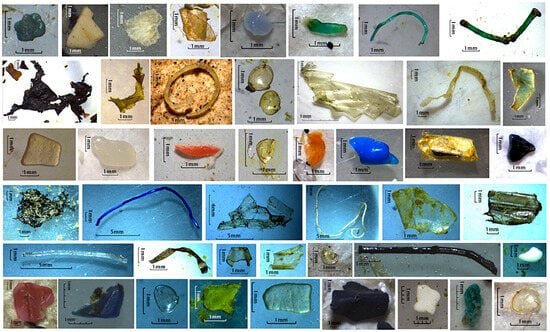
Figure 1
Highly Accessed Articles
Latest Books
E-Mail Alert
News
Topics
Topic in
IJERPH, Microplastics, Polymers, Toxics
Plastic Contamination (Plastamination): An Environmental and Public Health-Related Concern
Topic Editors: Rosaria Meccariello, Antonino Testa, Francesco Cappello, Antonietta SantoroDeadline: 30 June 2026
Topic in
Microplastics, Polymers, Sustainability, Toxics, Water
Microplastics Across Ecosystems: Multidisciplinary Approaches to Sources, Sinks and Health Sustainable Solutions
Topic Editors: Caio Rodrigues Nobre, Camilo Dias Seabra PereiraDeadline: 30 November 2026
Topic in
Fishes, Foods, Microplastics, Veterinary Sciences, Poultry, Animals, Ruminants
Micro- and Nanoplastics in Animals and Livestock Production
Topic Editors: Sonia Tassone, Beniamino T. Cenci-Goga, Samia Ben Said, Khalil AbidDeadline: 31 December 2026

Special Issues
Special Issue in
Microplastics
Microplastics and Human Health: Impact, Challenges and Interaction Mechanisms
Guest Editor: Javier BayoDeadline: 31 March 2026
Special Issue in
Microplastics
Microplastics in Freshwater Ecosystems
Guest Editor: Piotr ZielińskiDeadline: 31 August 2026
Special Issue in
Microplastics
Micro- and Nanoplastics Beyond the Mainstream: Understudied Dimensions and Emerging Approaches
Guest Editors: Manuela Piccardo, Antonio TerlizziDeadline: 30 September 2026
Special Issue in
Microplastics
The Role of Recycling in Reducing Microplastic Pollution in Textile Industry
Guest Editors: Maria Râpă, Carmen GaidauDeadline: 30 September 2026
Topical Collections
Topical Collection in
Microplastics
Feature Papers in Microplastics
Collection Editor: Nicolas Kalogerakis


